Support for Stressful Times
You are here and it matters. We invite you to take a moment to pause by breathing in through your nose to the count of 4, then hold your breath for 2, and exhale out through your mouth for 5. Try this 3 to 5 times in a row. Notice if you feel different inside your body. You have practiced self-care during this last minute. Taking care of yourself can be as easy as intentional deeper breathing.
You matter! Taking care of yourself matters too. Taking care of yourself means that you can decide to act in moments when emotions feel big to bring a sense of calm and balance to yourself.
You can add in more ways to cope that are doable. Simple changes and shifts in your actions can prevent stress and anxiousness. Moving, deeper breathing, humming, and being playful are some of the ways to cope and bring well-being to your life.
Creating small changes can result in feeling better equipped to find joy, notice the beauty, manage through upset, and seek well-being.
You deserve to treat yourself with loving-kindness. Learning new strategies can prevent or reduce the impact of chronic stress.
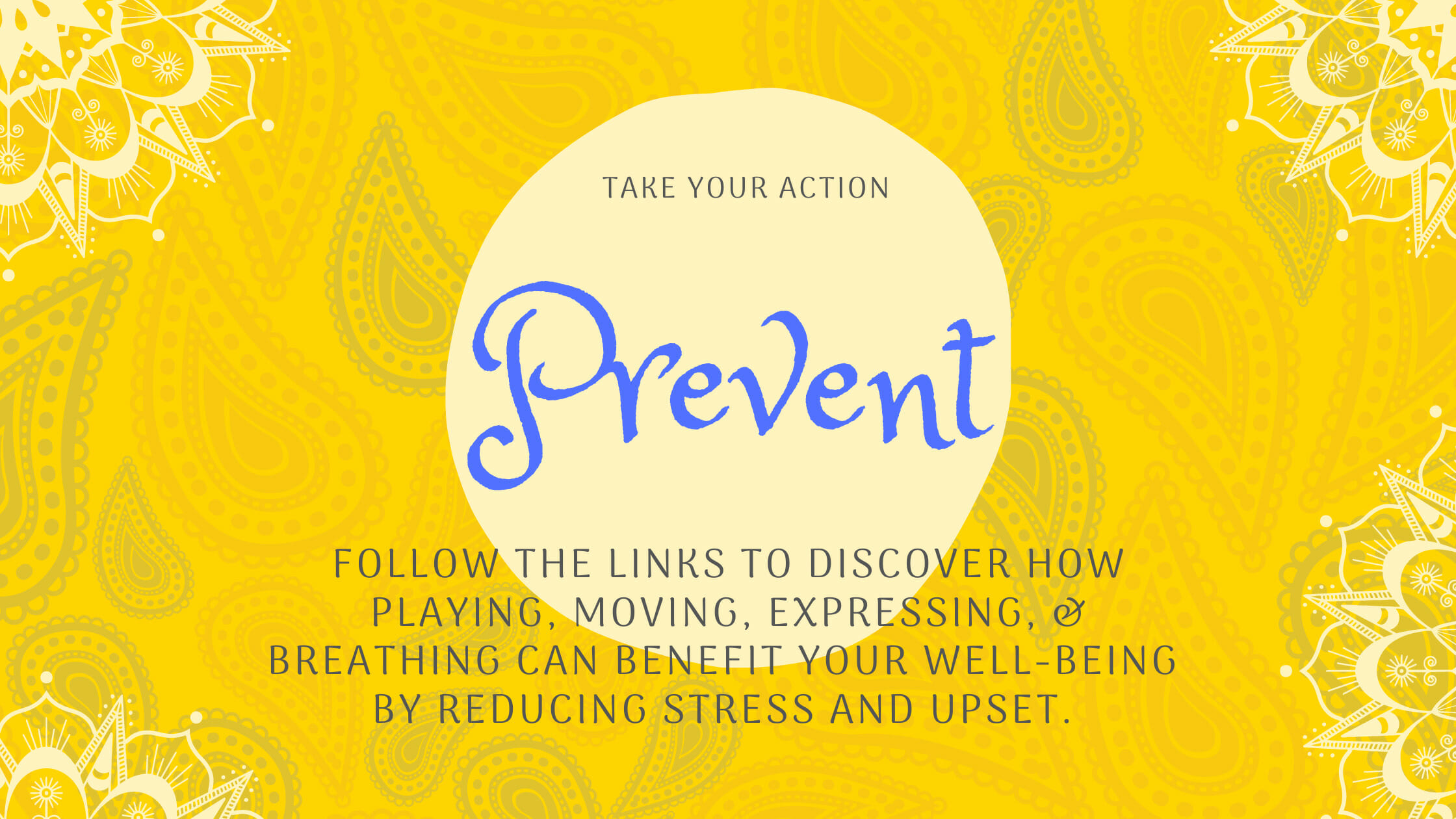
This past year, we have experienced much change as individuals, in our chosen family, within our communities, and as a world. As people, we know that COVID-19 changed our lives. This global pandemic has shifted our lives, caused strong emotions, and impacted how we move about and connect. Many of us have experienced losses. Children, teens, and adults have been affected and challenged.
As the Center for Disease Control (CDC) states, “Public health actions are necessary to reduce the spread of COVID-19, but they can make us feel isolated and lonely and can increase stress and anxiety. Coping with stress in a healthy way will make you, the people you care about, and those around you become more resilient.”
Experiencing stress in life is normal. Knowing how stress can affect you or others is vital to understand. This understanding provides validation for our feelings and experiences. Awareness regarding the impact of stress on our emotions, in our lives, and how we feel inside our bodies provide us with an opportunity to try (new) approaches to get through hard stuff when we feel upset, worried, or tense.
As the CDC describes, “Stress can cause the following:
• Feelings of fear, anger, sadness, worry, numbness, or frustration
• Changes in appetite, energy, desires, and interests
• Difficulty concentrating and making decisions
• Difficulty sleeping or nightmares
• Physical reactions, such as headaches, body pains, stomach problems, and skin rashes
• Worsening of chronic health problems
• Worsening of mental health conditions
• Increased use of tobacco, alcohol, and other substances
It is natural to feel stress, anxiety, grief, and worry during the COVID-19 pandemic.”
Links to Current Information for the Coronavirus
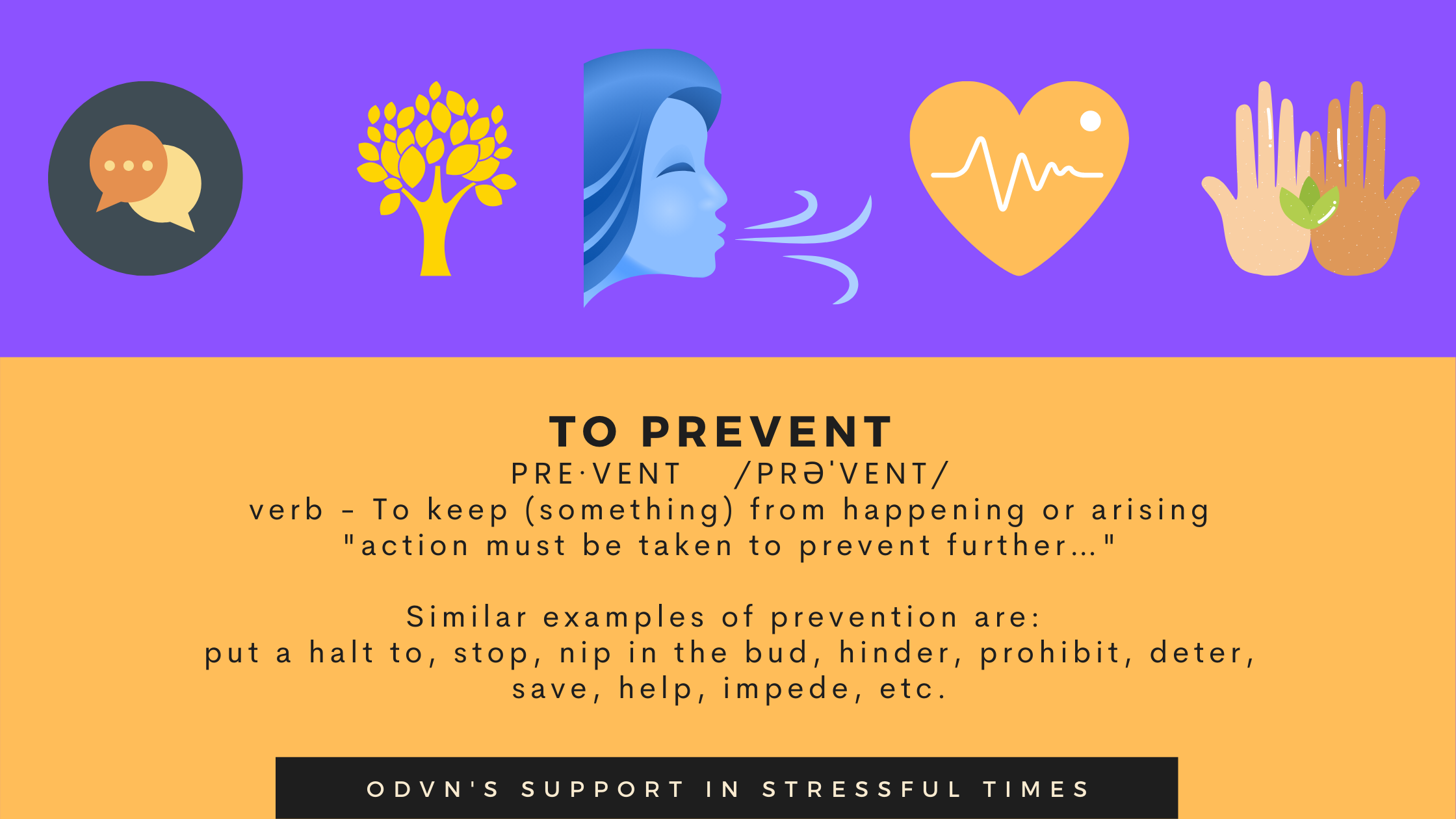
It is so important to find ways to help yourself to manage experiences of stress. Indeed, some simple shifts or changes in what you decide to do and think can positively help you and those you care for when it comes to managing stress.
The mind, body, and spirit are interconnected. One simple yet profound change we can make is to breathe more deeply throughout our day. Deeper breaths stimulate the vagus nerve inside our body to calm and balance us. Some benefits to shifting from shallow breathing (shorter, quicker breaths) to deeper breathing (inhale and exhale longer) can lower our heart rate, reduce our blood pressure, and release tense muscles. Deeper breathing regulates our parasympathetic nervous system “to calm” us.
We invite you to follow the links in the word “Prevent” (in the tabbed section below) to discover ideas, techniques, and resources. These links, activities, and videos show positive ways to cope and reduce the impact of stress in your daily life.
Mental Health During Times of Extreme Stress of Crisis
If you are experiencing extreme feelings of upset and overwhelm, please know there are many ways to get help.
Ohio’s Crisis Text Line
The Crisis Text Line is a free, confidential service available 24/7 via text on mobile devices. Throughout Ohio, you can text the keyword “4hope” to 741 741 to be connected to a trained Crisis Counselor within 5 minutes. People of all ages can use the crisis text line.
If you are in crisis, get immediate help:
Resources from the CDC
• Call 911
• National Suicide Prevention Lifeline: 1-800-273-TALK (8255) for English, 1-888-628-9454 for Spanish, or Lifeline Crisis Chat
• National Domestic Violence Hotline: 1-800-799-7233 or text LOVEIS to 22522
• National Child Abuse Hotline: 1-800-4AChild (1-800-422-4453) or text 1-800-422-4453
• National Sexual Assault Hotline: 1-800-656-HOPE (4673) or Online Chat
• Veteran’s Crisis Line: 1-800-273-TALK (8255) or Crisis Chat or text: 8388255
• Disaster Distress Helpline: CALL or TEXT 1-800-985-5990 (press 2 for Spanish).
• The Eldercare Locator: 1-800-677-1116 – TTY Instructions
Public Benefits
Sometimes we can struggle to make ends meet. Maybe we lose our job or we have to stop working to care for a loved one. Or maybe, no matter how hard you work, there just isn’t enough. When this happens, there are programs that can help you care for yourself and your family.
Most Americans receive some kind of public benefit during their life. There is no shame in using any available resource to put food on your table or keep the roof over your head.
This section has information about several major benefits programs that you may be eligible for, including what the program provides, how to apply, and how much money you can make and still qualify.
Here’s the link to find the food banks for Ohio’s counties.
The Impact of Experiencing Stress
Experiencing the ups and downs of living is something that we do every day. We encounter daily inconveniences that create opportunities for us to solve them. So, some stressful experiences can have benefits, which is called positive stress. We learn about ourselves and gain confidence, become more sure of our skills to manage situations, and learn self-resilience.
Still, there are experiences that are stressors of a different kind, different from the ups and downs. They range from mild acute stress to chronic stress.
As the Mayo Clinic describes, “Stress is your body’s reaction to the demands of the world. Stressors are events or conditions in your surroundings that may trigger stress. Your body responds to stressors differently depending on whether the stressor is new or short term — acute stress — or whether the stressor has been around for a longer time — chronic stress.
Acute Stress
Also known as the fight-or-flight response, acute stress is your body’s immediate reaction to a perceived threat, challenge, or scare. The acute-stress response is immediate and intense, and in certain circumstances, it can be thrilling. Examples of acute stressors include having a job interview or getting a speeding ticket.
Chronic Stress
Mild acute stress can be beneficial — it can spur you into action, motivate and energize you. The problem occurs when stressors pile up and stick around. This persistent stress can lead to health problems, such as headaches and insomnia. The chronic-stress response is more subtle than is the acute-stress response, but the effects may be longer-lasting and more problematic.
Know Your Stressors
Effective stress management starts with identifying your sources of stress and developing strategies to manage them. One way to do this is to make a list of the situations, concerns, or challenges that trigger your stress response.”
Decide now to continue exploring, notice where you feel the tension in your body, be curious about what you might be resisting, and discover new ways to take care of yourself actively.

Click on each letter below to discover ways to support and strengthen your well-being.
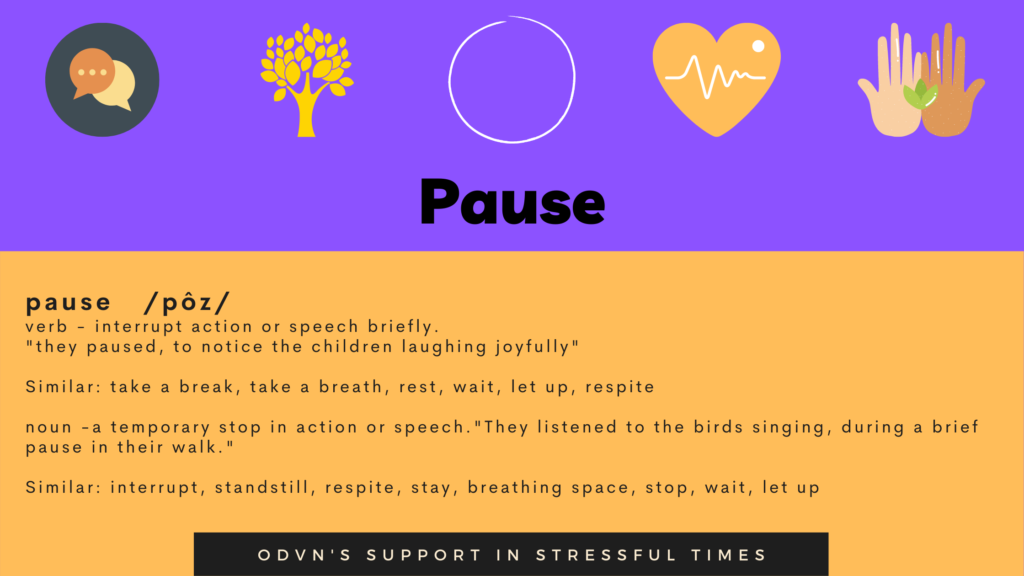
Pause, here and now. Notice where you are, notice what you hear, notice what you see, and notice how you breathe. Pausing is an action that we can take to rest our minds and our bodies. Pausing, and practicing to pause, is something that we can begin doing right now. There is much research that suggests that pausing and resetting our inner balance is a stress reducer. Please take a moment to look at this video from ZENworks Yoga.
Mind in a Jar
Disclaimer
For anyone, but particularly those with a history of trauma, calling attention to our breath and body has the potential to trigger our nervous system. That is, to increase feelings of anxiety, frustration, or even anger. Research shows that breathing and mindfulness practices work to activate the “resting” part of our nervous system. However, being still and quiet and focusing on what we feel can be uncomfortable or difficult at times.
The good news is, there are things that you can do to help including:
- Notice your surroundings before you begin and when you finish
- Keep your eyes open if that feels more useful
- Pay attention to body sensations rather than emotions; if emotions feel too big
- Tune into your senses to stay in the present moment (notice what you see, hear, feel, touch and taste)
ZENworks Virtual Yoga Studio
Breathing Practices
Mindful Moments
Chair Poses
 |
ZENworks Yoga in Northeast Ohio contributed their videos and activities to give us examples of how to take mindful moments, do breathing exercises, and sitting poses. Pausing and practicing can boost our well-being. Click on these links and allow ZENworks Yoga to show you examples of how pausing, breathing, and resetting can reduce tension in your mind and body. Sonya Bapna Patel, Founder + Executive Director |
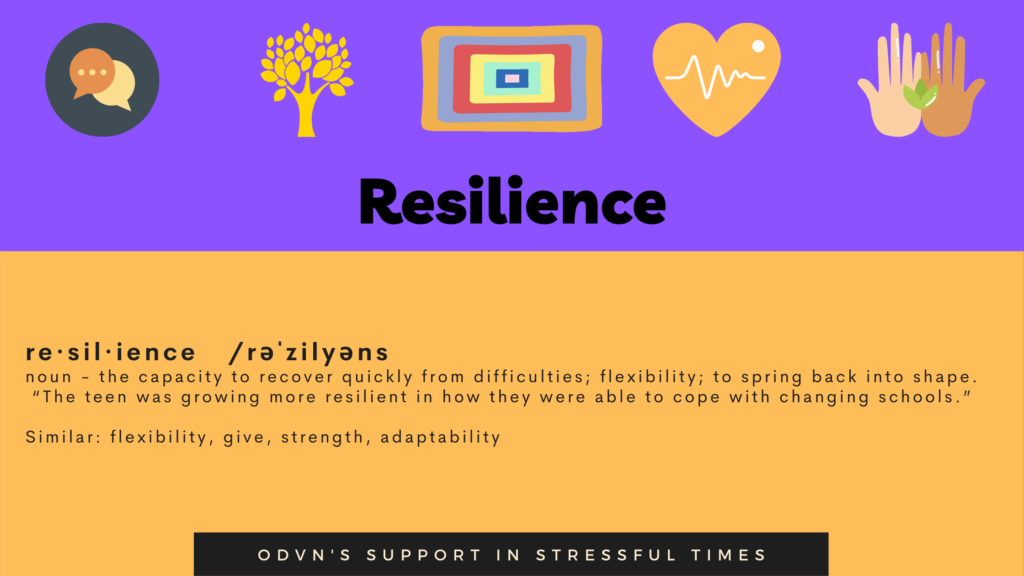
We know that in living our lives, we have different experiences. In these different experiences, we encounter challenges and stress. Adjusting and adapting is how we manage through these experiences. The good news is that bolstering our resilience has many positive benefits for our well-being.
- Resilience means our ability to adapt or adjust despite adversity or challenging circumstances.
- Resiliency is a learned behavior of practical strategies in how to deal with stress and difficulties.
Resiliency is not a trait we are born with, as some would believe. We can develop a capacity for resilience at any age and throughout our lives.
Being more resilient doesn’t mean that we avoid painful times, stressors, or losses. It means that we have hope in knowing we can get through these distressing experiences because we have “grown” or fostered skills in “how to” manage or cope when going through them.
- Being resilient means we have a plan of practical strategies (or new techniques) to do when we experience big emotions and distressing circumstances.
- Practical strategies include learning ways to regulate our internal body responses with deeper breathing and movement.
The Bounce Back Project described resiliency as having five pillars. By strengthening these pillars, we become more resilient. The five are:
- self-awareness,
- mindfulness,
- self-care,
- positive relationships, and
- purpose.
To enhance our resiliency, it helps us to become aware of how to do this. Everyday Health described “resilient people utilize their resources, strengths, and skills to overcome challenges and work through setbacks.”
(Dec 10, 2020, everydayhealth.com/wellness/resilience/)
It is essential to recognize what we already handle many situations or stressors well.
- Recognizing what you are good at on the individual level helps you gain confidence in working through other difficulties or struggles.
- When we feel more confident about what we do that is working for us, we may feel a bit stronger to try another way to cope.
Knowing our triggers helps us anticipate what may come and plan to get through it emotionally and physically safe.
Many believe that getting through hard times is about our “will.” If we struggle, it means we have to try harder, or some say it’s “the pull yourself up by your bootstraps” mentality. This type of belief or thinking can leave us feeling isolated and unable.
The good news is some factors help strengthen our resiliency; they are many and can vary from person to person and in different situations.
The American Psychological Association (APA) offers these ten ways to build resilience:
- Make connections. “Accepting help and support from those who care about you and will listen to you strengthens resilience.”
- Avoid seeing crises as insurmountable problems. “Try looking beyond the present to how future circumstances may be a little better.”
- Accept that change is a part of living. “Accepting circumstances that cannot be changed can help you focus on circumstances that you can alter.”
- Move toward your goals. “Do something regularly—even if it seems like a small accomplishment—that enables you to move toward your goals.”
- Take decisive actions. “Rather than detaching completely from problems and stresses and wishing they would just go away, act on adverse situations as much as you can.”
- Look for opportunities for self-discovery. “People often learn something about themselves and may find that they have grown in some respect as a result of their struggle with loss.”
- Nurture a positive view of yourself. “Developing confidence in your ability to solve problems and trusting your instincts helps build resilience.”
- Keep things in perspective. “Even when facing very painful events, try to consider the stressful situation in a broader context and keep a long-term perspective.”
- Maintain a hopeful outlook. “Try visualizing what you want, rather than worrying about what you fear.”
- Take care of yourself. “Pay attention to your own needs and feelings. Engage in activities that you enjoy and find relaxing.”
3 Valuable Tools To Boost Your Resilience (YouTube) | BBC Ideas
Dr. Lucy Hone is a leading expert on resilience. She shares in the beautifully illustrated video her own experiences in loss and these pearls of wisdom, including:
- Understand that suffering is part of life.
- Tune into the good parts of your life. Remember those parts of your life.
- Ask yourself, ‘Is this helping me or harming me?’
- Being resilient is accepting your vulnerabilities.
- Other people matter.
The Quiet Power of Introverts (YouTube) | BBC Ideas
Are you an introvert? If so, that’s great! Animator Sofja Umarik (who is an introvert) looks at how it can be a real strength.
What’s Your Resiliency Score?
- Everyday Health Assessment: Get Your Resilience Score (Everyday Health)
- How to Build Your Resilience During the COVID-19 Pandemic (Everyday Health)
- 10 Ways to Build Resilience (Stanford Medicine)
- Building Your Resilience (American Psychological Association)
Supporting Youth’s Capacity for Their Resilience
Take a moment to watch this video! It is excellent information about how to help children manage and even thrive.
What is Resilience in Kids Created by First to Draw (YouTube)
Parents and caring adults can create space and experiences for children to strengthen their coping and adaptation skills. Being resilient doesn’t mean that young people will escape upset, overwhelm, or big emotions.
The 7 C’s of Resilience (YouTube)
What it does mean is that we have skills or ways to “manage through” these moments. The key is that adults model or show children how to cope in healthy ways, even when it is difficult or sad.
The 7 C’s resilience model was developed by pediatrician Ken Ginsberg, MD, to help children and adolescents build resilience. Learning competence, confidence, connection, character, contribution, coping, and control is how Ginsberg says we can build inner strength and utilize outside resources — regardless of age.
Supporting Youth’s Capacity for Resilience (American Psychological Association)
Resiliency factors include internal and external processes to build our inner strength and shift our focus.
The Harvard Center on the Developing Child (Harvard University)
The Harvard Center on the Developing Child states that resiliency characteristics “include a combination of supportive relationships, adaptive skill-building, and positive experiences is the foundation of resilience. Children who do well in the face of serious hardship typically have a biological resistance to adversity and strong relationships with the important adults in their family and community.”
Play, Move, Imagine: I Matter! I Belong! (ODVN’s Youth Journal)
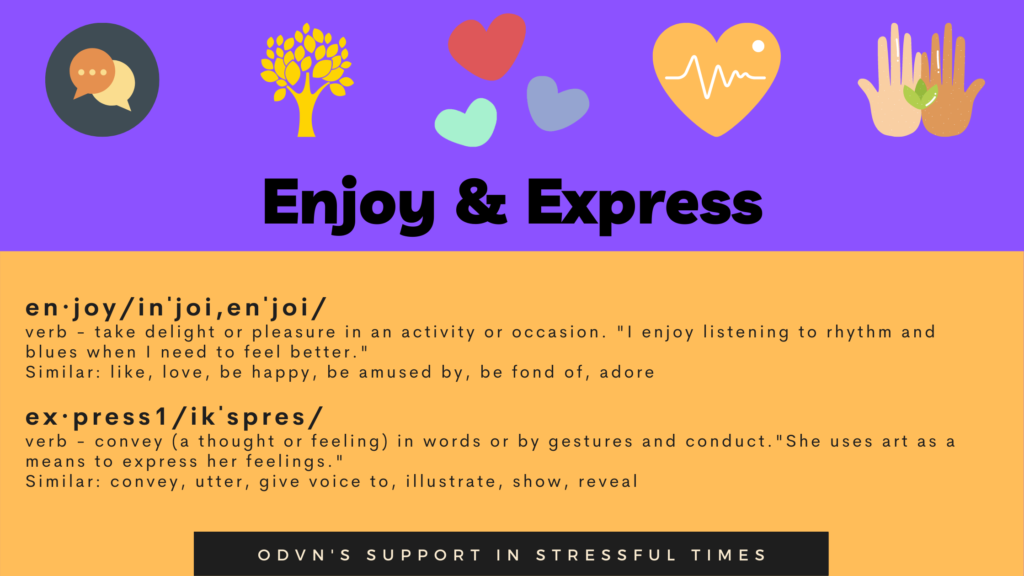
Discover how expressing gratitude and enjoying games, art, and doodling can improve your mood, outlook, and health benefits.
Enjoyment might need to be deliberately planned, especially in times of worry and physically distanced from others. Social connections are missing for many of us. It is vital to find pleasure throughout our day to boost our well-being.
Make intentional plans to find activities you enjoy doing, from playing games or cards to creating through doodling, art, or even journaling. Enjoying and expressing are keys to promoting happiness in moments throughout your day.
When we experience stress, upset, or overwhelm, our creativity can lessen. It is essential to counter-balance this by deciding to take pleasure in something. Note that you don’t have to venture into some huge project or trip to bring enjoyment. Activities can be as simple as listening to your favorite artist and singing along with them or baking your favorite cookies or casserole.
Let’s begin by discovering together the benefits of expressing gratitude.
According to Harvard University, “The word gratitude is derived from the Latin word gratia, which means grace, graciousness, or gratefulness (depending on the context). In some ways that the individual receives, whether tangible or intangible.
With gratitude, people acknowledge the goodness in their lives. In the process, people usually recognize that the source of that goodness lies at least partially outside themselves. As a result, gratitude also helps people connect to something larger than themselves as individuals — whether to other people, nature, or a higher power.
In positive psychology research, gratitude is strongly and consistently associated with greater happiness. Gratitude helps people feel more positive emotions, relish good experiences, improve their health, deal with adversity, and build strong relationships.
People feel and express gratitude in multiple ways. They can apply it to the past (retrieving positive memories and being thankful for elements of childhood or past blessings), the present (not taking good fortune for granted as it comes), and the future (maintaining a hopeful and optimistic attitude). Regardless of the inherent or current level of someone’s gratitude, it’s a quality that individuals can successfully cultivate further” (Harvard Health Publishing, 2011).
Link: Giving Thanks Can Make You Happier (Harvard Medical School)
Express Gratitude
- How To Express Gratitude to Others (19 Ideas + Gifts & Challenges) (PositivePsychology.com)
- 10 Ways to Express Gratitude (PsychCentral)
- 13 Most Popular Gratitude Exercises & Activities (PositivePsychology.com)
- How to Say Thank You in Many Languages (YourDictionary.com)
These links have different activities to help you express gratitude on a more regular basis. There are a combination of written, verbal, and conceptual activities, so you can decide what works best for you!
Ideas to Try
Some people set their phone alarms several times a day to remind them to express their gratitude for someone, something, or about themselves. Others keep a Gratitude Journal where they spend time writing and drawing, connecting appreciation to experiences.
Families have created gratitude jars or buckets together; they deliberately plan to write positive statements about their appreciation for an experience, an activity, or about themselves or someone else. They read these out loud together. It’s a fantastic way to model positive messages of thankfulness for the “small stuff.” Our world becomes a larger place when we can see what is right around us.
Another way to use a Gratitude Jar is for the parent to put in notes of appreciation about their child or teen. The young person can then read messages about themselves and possess written evidence that their caretaker made a positive statement about them.
Gratitude Letter • Making a Gratitude Jar (ODVN)
Links to Videos about Gratitude, Playing Games, Doodling
- PositivePsychology.com offers amazing resources for individuals and families.
- The Gratitude Tree for Kids (PositivePyschology.com) this page includes activities and drawings
- 14 Health Benefits of Practicing Gratitude According to Science (PositivePsychology.com)
Online Games for the Individual
Solitr.com (Solitaire, Sudoku, Mahjong, and Spider)
This website will keep your body calm and mind active by helping you focus on four fun, low-pressure games. They are great for teens and adults to play before bed or throughout the day.
Scrabble Games Online
Need to decompress after a long or challenging day? Online scrabble is the game for you- it will challenge your mind and always keep you entertained. This website is easy to use, and you can adjust the skill level of your virtual opponent as you please.
Online Games for the Individual or Multiple Players
Catan Universe
This is the official website for the popular board game Catan Universe and will direct you to the proper platform depending on your device. This is a very exciting and strategic game that is perfect for teens and adults to play to occupy large chunks of time.
CardzMania (Wide variety of card games)
From Crazy Eights to Euchre to Gin Rummy, this website has all of the best card games for families and people of any age. Young children can even enjoy some of these games! Check this website out and find which lighthearted virtual card games suit you and your loved ones the best.
15 Card Games that are Perfect for Your Next Family Game Night (Frugal Fun for Boys and Girls)
In-person games. This website has a whole list of directions to the best and most family-friendly games. All you need is a deck of cards and some energy so your family can have a relaxing night full of conversation and laughter. This website is ideal for families with children ages five and older.
10 Benefits of Doodling for Creativity, Productivity, and Focus (Canva)
Article on how doodling may reduce stress.
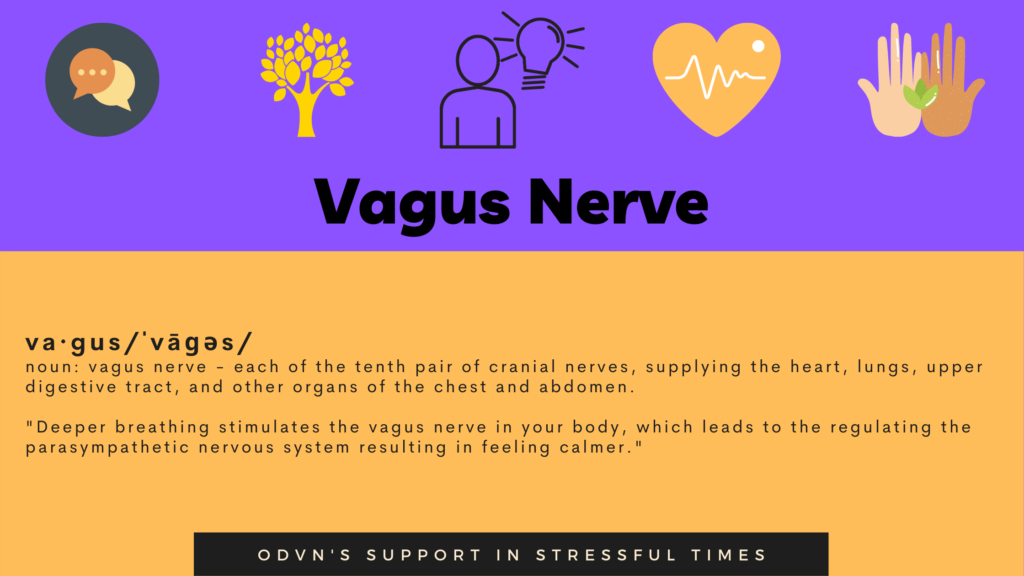
How Do Use a Simple 1-Minute Exercise to Tap into Your Vagus Nerve (YouTube)
So, what’s the vagus nerve, and why is it so important to understand? The vagus nerve is described to be your key in fighting stress.
Deep belly breathing, inhaling for 5 seconds, holding for 2 seconds, then exhaling for 6, 7, or 8 seconds, three times in a row is an example of deep diaphragmatic breathing. This breathing technique is an example of how to tap into your vagus nerve.
Deeper breathing stimulates the vagus nerve, which sends messages to your body to calm the parasympathetic nervous system. In other words, deeper inhaling and longer exhaling puts the brakes on the flight, fight or freeze response, which happens in our bodies when we react to stress or triggers.
Recall that we often shallow breath during times of stress and busyness of life, meaning that we take shorter inhales and quicker exhales out. Deeper mindful breathing counters this faster-paced breathing.
Understanding the importance of our body’s vagus nerve provided the key to reducing stress and upset. The vagus nerve is what relaxes us.
“The vagus nerve is listening to the way we breathe, and it sends the brain and heart whatever message our breath indicates. Breathing slowly, for instance, reduces the oxygen demands of the heart muscle (the myocardium), and our heart rate drops. Relaxing us,” shares Lucy Norcliffe-Kaufmann, Associate Professor of Neurology at NYU-Langone.
Learning more about the vagus nerve and how you can achieve a sense of calm is vital to reducing feelings and sensations of stress, upset, and anxiousness. You can also improve digestion and sleep, among many other benefits.
Katie Brindle Yang Sheng, in The Art of Chinese Self-Healing, described that “Letting your voice be heard, whether through singing, chanting, humming, or laughing will increase your heart rate variability and kickstart the vagus nerve so that it can send relaxing waves through your entire nervous system.”
“Breathing deeply, immediately, relaxes the body because it stimulates the vagus nerve, which runs from the neck to the abdomen and is in charge of turning off the ‘fight or flight reflex.”
See more examples below from Allied-Services.org:
- Breathe more slowly (aim for six breaths per minute).
- Breathe more deeply from the belly. Think about expanding your abdomen and widening your rib cage as you inhale.
- Exhale longer than you inhale. It’s the exhale that triggers the relaxation response.
Additional techniques for stimulating the vagus nerve include:
- Loud gargling with water or loud singing activates our vocal cords, stimulating the vagus nerve.
- Foot massage: gentle or firm touch can assist in stimulation the vagus nerve.
- Coldwater face immersion: immerse your forehead, eyes, and at least 2/3 of both cheeks into cold water. This elicits the vagus nerve, decreasing heart rate, stimulating the intestines, and turns on the immune system
- Eating fiber stimulates vagus impulses to the brain slowing the gut movements and making us feel fuller after meals
- Laughter: having a good laugh lifts your mood, boosts your immune system, and stimulates the vagus nerve.
- Reference: Megan Horeis, DPT.PT.WCS allied-services.org/news/2020/june/the-vagus-nerve-your-secret-weapon-in-fighting-s/
Brief Explanation of Trauma and the Vagus Nerve (ODVN)
Links
- A Mindfulness Teacher’s Go-To Breathing Exercise To Stimulate The Vagus Nerve (MBG Mindfulness)
- The vagus nerve: your secret weapon in fighting stress (Allied Services Integrated Health System)
- Vagus Nerve: Breathing for Relaxation | TuneUp Fitness (YouTube)
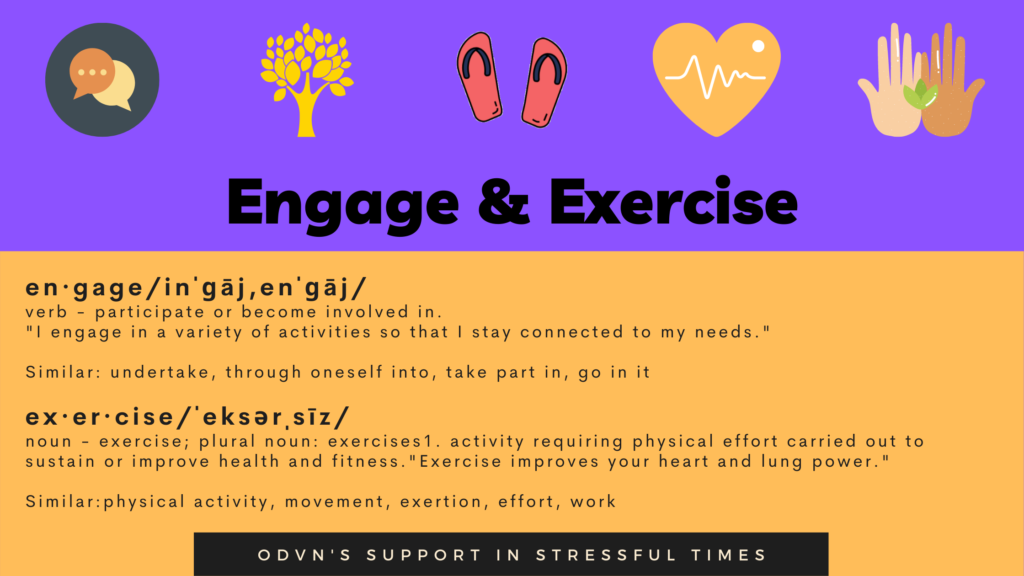
Getting up, moving about, and exercising is excellent for our overall mood and well-being. The CDC describes, “Regular physical activity is one of the most important things you can do for your health. Everyone can experience the health benefits of physical activity (CDC)–age, abilities, ethnicity, shape, or size do not matter.”
Benefits of Physical Activity (CDC)
Physical activity can help you to feel better, more focused, and even sleep better, too. There are many emotional benefits to moving or exercising. Taking brisk walks for 30 minutes a day has been shown to make a difference.
Many of us can’t afford a gym or don’t even live near a place that has a gym. That shouldn’t hinder our efforts. There are many ways to exercise inside our apartment, house, or outside where we live.
Sometimes, getting started is the most challenging part because we might be feeling distressed and down, not wanting to move or get up for the chair.
Start with small steps or goals, beginning with several days a week for 10 to 15 minutes and day. Then continue to build on your success.
- The CDC offers options to stay physically active while social distancing (CDC).
More Links to Exercise and Movement
- Chloe Ting (Individual home workouts (no equipment required), healthy recipes)
- Reduce stress and improve health with any of Chloe Ting’s free workout programs that target all parts of the body. She will definitely push you to stay active and become even stronger than you already are. Her website also includes a list of a bunch of healthy recipes if you want to check those out too.
- Aaptiv LIVE (Family fitness, mental health work through, and more)
- This YouTube fitness channel caters to everyone. There are workouts for adults, adults, and children, and even workouts to just get kids moving. Scroll through the different types of workouts and see what you like best.
- The Body Coach TV (Workout anywhere, kid-friendly, adult workouts)
- Tag along with Joe and see your body and mood improve instantaneously. Joe is funny, full of energy, and will kick you into shape in no time. He has workout videos for adults and children and shows that you can exercise indoors, outdoors, or anywhere you have space.
- Double Time (Partner workouts)
- Grab a partner and follow these incredible workouts produced by TeamBeachBody. These are great for parents and children as well as two adults. Though these workouts are primarily equipment-free, some exercises may require a ball.
- POPSUGAR Fitness (Individual, all levels, variety of workouts)
- No matter if you’re advanced or a beginner, everyone can find a class they like on this website. There are so many different types of workouts led by a bunch of different instructors. Some videos require equipment and others do not, scroll through and see what fits your personality and circumstances.
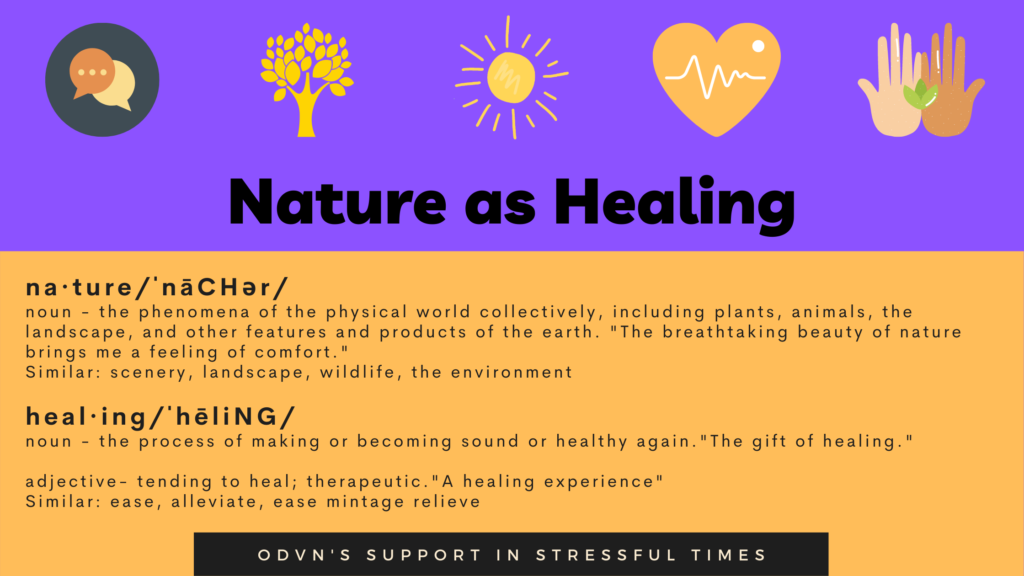
Noticing beauty all around can be soothing. It is vital we intentionally take the time to observe what is outside, either by opening the window or deciding to walk outdoors.
Nature is therapeutic. It is important to open our eyes, ears, and heart to the beauties and kindnesses in the world. Earth and nature share with us a rhythm that connects us all. There is a vibration and grounding experience when we come into the present moment with nature. This present moment can bring to us an awareness that beauty and suffering co-exists.
We engaged with our senses, using our senses of smell, sight, sound, touch, and taste. We can feel our feet connect to the ground when we walk, noticing a rhythm to this experience of connection.
We should look up and all around, engage our minds and bring our awareness into the present moment. We achieve this by taking in the fresh air, noticing the sensation of feeling a light breeze in the air, hearing the sounds of birds chirping, seeing the moment of the trees dance with the wind, hearing the hum of traffic passing by, and seeing the many shades in nature.
There is research showing how spending time in nature can improve mental health. Reports indicate that spending time in nature can help improve cognition and brain and overall health and well-being. Feeling connected to nature can produce similar benefits to well-being, regardless of how much time one spends outdoors.
Another way to bring nature to you and your family is to consider cultivating plants, try in-door gardening along with growing flowers that are native to Ohio. Check out the links and resources shared below:
- The Healing Powers of Nature (Shondaland)
- What is the Japanese Art of “Forest Bathing” and How Can It Help Your Health? (YouTube)
- How Does Nature Impact Our Wellbeing? (University of Minnesota)
Benefits of Gardening
There are benefits to gardening rooted in emotional well-being, physical activity, vitamin D exposure from sunshine, and the joy of watching a beautiful plant grow to a flower, herb, or vegetable.
You can live in a one-bedroom space and still find a way to garden on a smaller scale by using bowls, pots or even mason jars. Some people hang herbs and plants in from their curtain rods while others use tables and shelves.
Nurturing a plant to grow in a simple way keeps you attending to its care.
Here are links providing more information about the benefits of gardening whether that be with vegetables, flowers, or plants inside or out. Think about including young people. They love playing in the dirt, discovering bugs, watering, and caring for something that needs them to grow.
Additional Links
- See 25 native Ohio perennials for your garden: vibrant color and deer-resistant! (Cleveland.com)
- Apartment Gardening for Beginners (The Spruce)
- Detailed information about growing plants indoors and outdoors in apartments
- Community Garden City of Columbus (The City of Columbus)
- Support for starting a community garden
- Community Garden (Franklin Park Conservatory)
- Franklin Park Conservatory Growing to Green
- Healthy Food Local Matters (Local Matters)
- Access to healthy food and resources
- Easy Plants for Kids to Grow (HGTV)
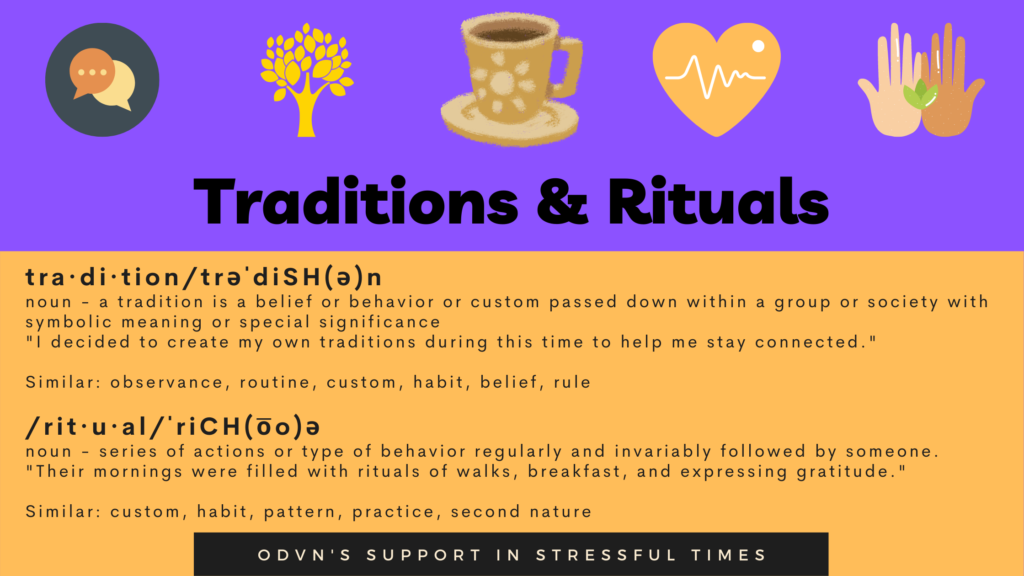
What do you do that gets your morning going?
If you stop and think about it, what might your afternoon habits include?
As you are winding down for sleep, do you have certain behaviors that you do now to help aid in falling asleep?
Commonly, traditions and rituals we observe are marked by our culture or, perhaps, family. Holidays are the most common ones we celebrate. Still, we create individual ones for ourselves or those rooted in religion, community, or culture.
In times when life shifts, it is vital to create or restart your own individual traditions or rituals that anchor you to your day or in your moment. Simply put, practical activities.
Some examples of daily rituals are:
- Begin your day with a positive affirmation practice expressing gratitude for something you appreciate (know that your if can be self-gratitude to name a strength you possess or nurture)
- Starting your morning with 16 ounces of water before enjoying your coffee or tea
- Looking out your window in the morning while eating your breakfast, setting the social media or emails aside
- Showering with an awareness of the warm water beginning your day with a fresh start, releasing the thoughts in your minds that want to advance you to your day (use your breath as we have learned)
- Walking outside with all your senses engaged to what is around you at some point in your day
- If you are home with children present, take deliberate time sitting with them on the floor while playing, talking, and singing songs together
- Planning to drink more water throughout your day to provide hydration to reduce fatigue and release toxins
- Selecting one, two, or even three practical strategies like tapping, listening to guided imagery, or perhaps restorative poses to aid in emotional regulation and well-being
- Planning a wind downtime in the evening to promote restorative sleeping practices
What are several of your own ideas or activities in building rituals into your life or within your circle of people? Grab some notepaper and write them down, perhaps so that you can come back to your ideas and implement them.
Allow grace to yourself. If you miss a day, afternoon, or evening ritual, merely begin again.
My Ideas for Daily Rituals (ODVN)
Links and Resources
Try a Tapping Ritual
- Tapping with Kids – Getting Your Day Started (YouTube)
- How to Use Tapping to Relieve Stress (YouTube)
- 3-Minute Tapping Video to Reduce Anxiety with All That is Going On (YouTube)
Positive Affirmations Practice
- 25 Daily Affirmations to Improve Your Mindset (The Blissful Mind)
Guided Imagery Ritual
- Guided Imagery Meditation (Help Guide)
Guided Imagery Rituals for Children
- Guided Meditation for Kids – Free Relaxation Scripts for Kids (Green Child Magazine)
- Let Go Of Worries | A Guided Meditation for Kids (YouTube)
Restorative Poses
- Restorative Yoga Poses (Yoga Journal)
- Restorative Yoga – Legs up the Wall Pose aka Viparita Karani (YouTube)
- Legs-Up-the-Wall Pose (Yoga Journal)
- Subtle Yoga: Legs up the Chair and Benefits of Inversions (YouTube)
- 15 Minute Mindful Mediation (YouTube)
Restorative Sleeping
- Restorative Sleep Rituals (Halsa Health)
- How to Sleep Better (Help Guide)
Stress Release Practices
- Quick Stress Release Strategies (Help Guide)
Funding for this publication was made possible by the Centers for Disease Control and Prevention cooperative agreement number 5 NUS4CE002310-03-00. The views expressed herein do not necessarily reflect the official policies of the Department of Health and Human Services, nor does the mention of trade names, commercial practices, or organizations imply endorsement by the U.S. Government.
Get in touch. Get involved.
174 E Long Street #200 Columbus, OH 43215
1.800.934.9840
614.781.9651
